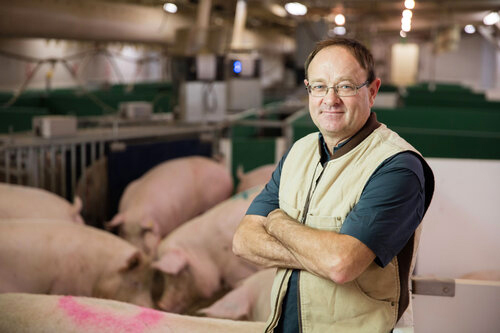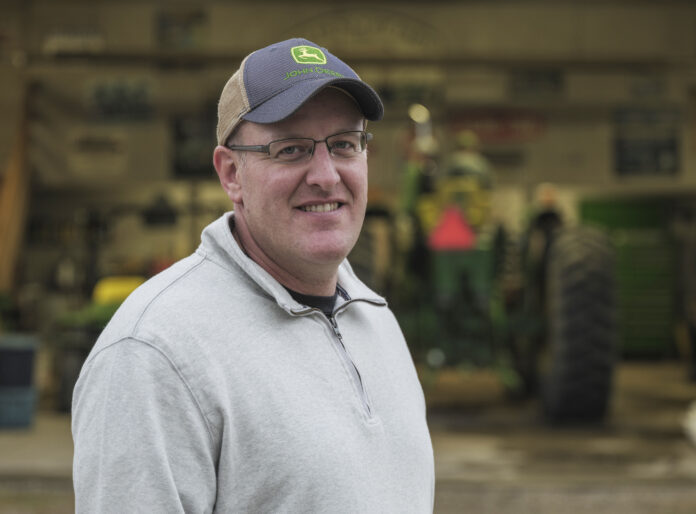By Ontario Pork
With COVID-19 restrictions easing, producers and industry partners have been eager to see each other face-to-face, attending meetings the same way we did prior to the pandemic.
While in-person events are mostly preferred to virtual ones, the new virtual reality that has emerged since COVID-19 is also showing some benefits when it comes to creating connections between producers and between producers and consumers.
In Ontario, two prominent producers have shown great initiative in leveraging the advantages that digital spaces can provide – from sharing information with each other, to sharing information with classrooms and the general public.
Producers can now meet, no matter where

In February 2021, Dave DeVries, who farms near Mapleton, just south of London, started planning a virtual meeting place for pork producers – dubbed ‘Swine Online’ – motivated by a TED Talk at the Ontario Agricultural Conference. Collaboration was key to its success, starting with the witty name.
“My wife, Lauren, gets full credit for that,” said DeVries.
Fellow producers Brett Israel and Daniel Roelands, who farm nearby, worked with DeVries on the details. Tim Blackwell, Ontario’s Chief Provincial Veterinarian, enthusiastically embraced the plan.
“We got a positive response right from the start,” said DeVries. “People definitely wanted it to continue.”
Laura Eastwood, a swine specialist with Ontario Agriculture, Food and Rural Affairs, gave them access to a secure Zoom platform with a chat option.
“Laura is our technical guru,” said DeVries. “She runs the sessions and helps with any connectivity issues.”
Blackwell acts as moderator, and Jaydee Smith maintains the online blog. Recordings are put on a password-protected website for subscribers to view at any time.
“The communication staff at Ontario Pork have also been very helpful in promoting the meetings,” said DeVries. “We have a great group of producers joining us now, some from as far away as Iowa and Saskatchewan.”
Polling questions are sent in advance to find producers who can speak to specific topics, ranging from loading area logistics, to feed costs, to the industry’s carbon footprint and environmental sustainability. Producers can showcase their operations through slides or videos, and products may be discussed, but DeVries cautioned that this is a neutral platform with no place for advertising or sales pitches. He also pointed out the advantages of online meetings.
“For one thing, you don’t have to buy doughnuts,” said DeVries. “Many producers say that they really appreciate being able to see operations all over the province, and there are no biosecurity issues in virtual visits.”
Community connections create interest

Most pork producers are proud to show off their barns and operations, and John Van Engelen of Hog-Tied Farms Ltd., east of Sarnia, is no exception.
Van Engelen’s modern, fully wi-fi-enabled pig barn is ideal for virtual tours. He has been doing online tours for a few years, both for school groups and for other farmers.
“Last year, I was asked to do a farm tour for the Western Fair, and I guess it went well,” said Van Engelen. “Because then the Royal Winter Fair asked me to do theirs, too.”
Van Engelen’s virtual tours have become a popular way for anyone who has never seen a modern pig farm up close to understand how pork production really works. Technology is integral to the operation. His sows are fitted with radio-frequency identification (RFID) tags, which his electronic sow feeders read to ensure each pig receives its specific ration and precise amount, according to size and gestation state.
His hogs are sorted and fed different rations depending on their individual weights. He also uses RFID tags on his hogs in Pig Performance Testers to track growth and gains, to get an average meat per tonne of feed throughout the year.
Van Engelen’s farm was one of the first in Ontario to install an electricity-generating wind turbine, and he even designed a shower for the pigs to enjoy. Presenting urban students his clean, modern barn helps them feel engaged with local farmers.
“When people get to see for themselves how calm, healthy and well-treated the pigs are, it makes a much better connection,” said Van Engelen.
When he gives tours to younger schoolchildren, they mostly want to see cute piglets, but older students are much more informed and aware of the contemporary social issues with farming. They come armed with tough questions about environmental sustainability and animal welfare. Van Engelen welcomes this as an opportunity.
“Most people don’t know much about their food sources, and there are a lot of misconceptions,” said Van Engelen. “The tours are a great way to educate and inform them.”
Van Engelen estimates that, in his time on the farm, his environmental footprint has dropped by half or more. He uses his barn’s own manure as fertilizer and minimizes energy costs with heat exchangers.
“I can raise a larger pig in 50 days less than it used to take to bring one to market 40 years ago,” said Van Engelen.
The most important part of the tours, for him, is that they help make real connections between the community and the food producers they depend on.
“It’s important to correct misunderstandings about farming. This isn’t Old McDonald’s farm anymore,” said Van Engelen.
Embracing, rather than fighting, change
Swine Online and Hog-Tied Farms’ tours are great examples of how producers have demonstrated resilience through the COVID-19 pandemic. Embracing innovation and technology to share experiences will help build long-term connections across the industry.
Even as in-person meetings and events return, it is likely that virtual options, when they make sense, will become permanent in our industry and many others.




